The Mount Everest Base Camp trekking experience is a fabulous adventure in which you will be exposed to spectacular natural scenes on the top of the world. You also will get ample opportunities to get exposed to the Sherpa culture. In this post you will find tips and recommendations on how you can prepare for this trek and enjoy it responsibly. Details of the trek are nicely presented in the Lonely Planet Nepal 11 (Country Guide)” target=”_blank”>Lonely Planet Nepal. A return trek from Lukla to Everest Base Camp will last about two weeks. I’ve done the trek twice and look forward to doing it again.
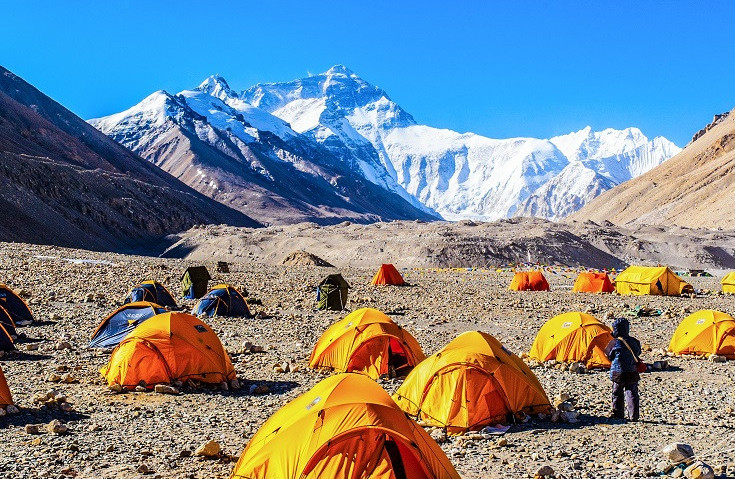
Mt. Everest Base Camp
Preparations for your trek
For a trek on high altitude to an elevation of 5,300 meters at base camp it is clear that one has to be fit enough. One does not need to be a “super athlete” to complete this trek. Very important is that you did your regular walking practice during the months preceding your trek, I would say at least 3 to 4 times per week a long distance walk of a couple of hours. Then you have to select the right season for the trek, when it is not too cold, and not during the rainy season. The period of the end of April to the end of May is fine, and the peak trekking season is from the end of September to November.
You will also need the right equipment to make your trek successful. The following items are essential;
– A good sleeping bag, with inner lining. For the April to early June and end of September to November trekking seasons, a 4 season down sleeping bag or a good 3 season bag should be sufficient.
– Trekking poles are an absolute essential part of your gear, it makes trekking so much easier and safer. Why buying poles, be sure to look for trekking poles, and not Nordic Walking poles. Most trekking poles are adjustable so that they can easily be packed away and so that they can be adjusted for different terrain.
– Good hiking boots: to give support to your feet and limit the risk of a strained foot, mid- to high-cut models give more protection. If you plan to trek without a porter and carry a heavy load with you, backpacking boots with a high cut that wraps above the ankles for necessary support. For backpacking boots, you should take enough break-in time.
– Jacket; It is essential that you choose a hiking jacket that is wind- and waterproof, and breathable at the same time. While selecting a jacket, take into account that you will wear various layers underneath it during your hiking trip. Choose a jacket that has some chest pockets, as these will be easily accessible when wearing a backpack.
– Sunglasses that can block UV rays are essential to protect your eyes as on high altitude you expose yourself to a high intensity UV rays. An environment of snow and glaciers intensifies the UV rays and hence making it essential tom wear sunglasses. In addition, also bring plenty of sun cream with a protection factor of 50 to protect yourself from sunburn.
– Consider also to bring a solar charger for your phone and camera batteries. You can fix the panel on your backpack for charging while trekking.
You also have to arrange the necessary permits in preparation of your Everest Base Camp trek. There are two different permits you need. The first is a Trekkers Information Management System (TIMS) permit, and in addition you need a Sagarmatha National park permit as a large part of the trek passes through this park.
Be well-prepared with a travel insurance that covers emergency evacuation (by helicopter). There is always a risk that you can not continue your trek due to an injury or other reason.
Start and finish in Lukla

Most trekkers to Everest base camp fly in to Lukla and start their trek there. The airport was built in 1964, with Sir Edmund Hillary involved in identifying the location of the site and lobbying for its construction to make the Solukumbu region better accessible. If you do not like to fly in, there is still the possibility to start a week-long trek from Shivalaya near Jiri, which is connected by road with Kathmandu.
Lukla is located at about 2,800 meter elevation. It is one of the most exiting airfields ofm the world; the runway is inclined so that planes can pick up speed rapidly when taking off and will brake fast when landing. This is needed as the airstrip is located between a cliff on one side and a steep descend on the other side.
Going up…
Day 1:
Most trekkers to Everest Base camp start their trip in Lukla. If you arrive on a morning flight, you can still start your trek already that day and move on to Chablung or Phakding.
Day 2:
Continue your hike to Namche Bazar (3420m), and enjoy your first steep climb all the way from the Dudh Kosi river to Namche. On your way you will enter the Sagarmatha National Park.
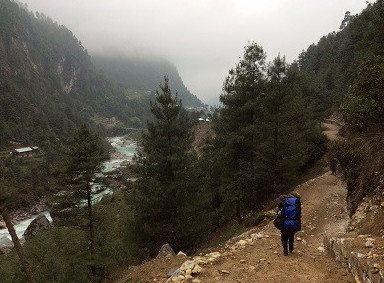
The Everest trek brings you along a wide variety of landscapes, starting with a hike through pine forests along the Dudh Kosi river between Lukla and Namche.
Day 3:

View over Namche Bazaar
Namche is a good place to stay one extra day to acclimatize to the higher altitudes. It has plenty of outdoor gear shops if you still need to upgrade your gear for the trek ahead. You can make a one-hour hike to Hotel Everest View near Syangboche Airport with it stunning views. The location is surrounded by majestic mountains including Mt. Everest.
Day 4:
The next stop on the way up brings you from Namche Bazaar to Tengboche, On the way you descend to the Dudh Kosi river, where you pass along a series of water driven prayer wheels. From there you start a steep ascent of 400 meters to Tengboche, with its beautiful gompa, with Mount Ama Dablam on the background.
Day 5:
From Tengboche you can trek to Pheriche (4240 m) or Dingboche, where it is recommended to acclimatize again one day on day 6.
Day 7;
This is a short day with only about 2 hours trek, which brings you to Duglha on 4340 m, from where you can continue on day 8 to Lobuche. You will pass a group of memorials to lost climbers, trekkers and Sherpas. One memorial here is for Scott Fischer, who died in the 1996 Everest disaster. You will also have beautiful views of Mt. Pumori this day.
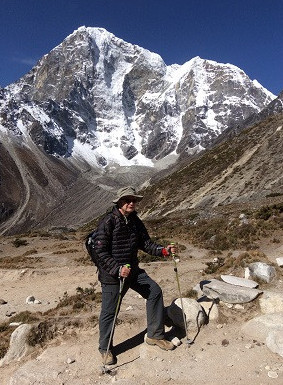
View on Mt. Pumori on the background
On day 9 you can trek from Lobuche to Gorak Shep (5160 m).
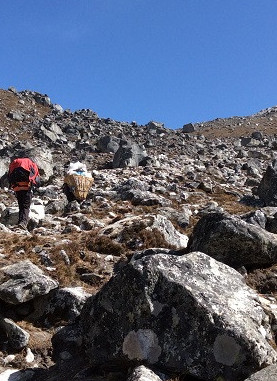
The trail between Luboche and Gorak Shep
This will only take three hours, so if you leave early enough and still have enough energy, you can install already in the lodge at Gorak Shep and continue to Kala Patar (5545 m) from where you have an excellent view over Mt. Everest and the Khumbu Ice fall.
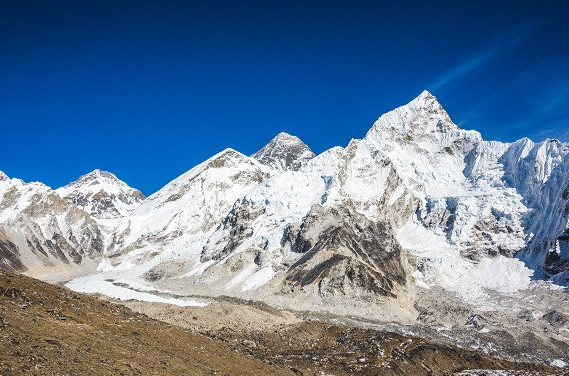
View on Mt. Everest and Khumbu Ice fall from Kala Patar
On Day 10 you can then go from Gorak Shep to Everest Base Camp and return to Lobuche. From there you can return to Lukla in about 4 days, so the whole trek will take you 14 days then.
Enjoy a safe trek
There is always a safety and security risk while trekking on high altitude in the Himalayas, but one can make an effort to limit the risks as much as possible. Be well-prepared for your trek. Take your time to acclimatize while going up. A safe rule of thumb is to limit your increase in altitude to not more than 500 meters per day. While going up, trekkers typically take acclimitization days at Namche and Periche to avoid altitude sickness caused by low oxygen levels in the air at higher altitudes. For a safe trek it is recommended not to travel alone. You can also take a trekking guide or a porter to accompany you.
It is better to limit yourself to vegetarian dishes only during your trek. In the Sagarmatha National Park where the trek passes through, it is not allowed to slaughter animals, so all meat is carried up by porters from Lukla, which increases the likelihood that the meat will go bad and makes you sick.
Everest base camp trek highlights
The scenic flight from Kathmandu to Lukla is already a highlight at the start of your trek. The changing landscapes along the trekking route is also one of the great experiences of the Everest base camp trek.
Other primary highlights of Everest Base Camp Trekking the Sagarmatha National Park that you will pass through and your visit to scenic locations like Namche Bazar, Tengboche Monastery, Kalapatthar, and Everest Base Camp. You will enjoy breathtaking mountain views and exposure to Sherpa people and culture.
